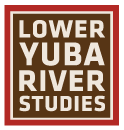Sediment Influx
Introduction
In an unregulated catchment, sediment flux plays an important role in geomorphic change. Once a river is impounded, sediment transport and delivery is disrupted and the rate of geomorphic dynamics is often reduced. Knowledge about the pre-dam influx of sediment can be useful in understanding baseline conditions. However, the LYR is somewhat unique in that it stored a vast amount of sediment in its river corridor prior to damming as a result of historic hydraulic gold mining. Consequently, sediment transport remains vigorous in the LYR even though sediment influx is small. In this context, information about pre-dam sediment influx provides insight into severity of historic impairment due to gold mining.
Past Sediment Influx Studies
- Gilbert (1917) characterized the quantity and texture of sediment coming from hydraulic mining in the Yuba River catchment.
- USGS Upper Yuba River Studies Program investigation of sediment behind the dam (Snyder et al., 2004a,b). Used drilling down the length of the reservoir to explore the stratigraphy of the thick deposit. Applied two different extrapolation schemes to estimate the volume and mass of each size fraction of sediment in each reach of the reservoir.
- Snyder et al. (2006) analyzed the hydrologic history of the Englebright-Lake catchment in the 20th century and related that to variations in lake levels and the lake’s depositional history. Englebright Dam is a 100% barrier to the flux of sand, gravel, cobble, and boulders. Turbid water carrying silt and clay sized particles goes over Englebright Dam during floods.
- Curtis et al., (2005) developed a conceptual model of sediment processes for the Yuba River watershed. They used GIS to estimate the spatial pattern of hillside susceptibility to erosion.
- Pasternack (2008) re-analyzed the Snyder et al. (2004a,b) data to isolate the gravel/cobble loading to have an upper bound on unregulated gravel/cobble influx to the LYR.
- James et al. (2009). “The immense deposit in the lower Yuba River alone represents 24% of the hydraulic mining sediment produced from 1853 to 1884”. [That is ~253 million cubic meters of sediment.] “Most mines in the Yuba Basin dumped sediment into extremely steep, narrow canyons, where it was quickly and efficiently delivered downstream to alluvial fans and basins in the valley.”
Current Sediment Influx Understanding
On an annual basis, the modern load of gravel and cobble- not all sediment, but of gravel and cobble- into Englebright Lake is 61,600 yds3/yr. That is driven by significant watershed cumulative impacts, including legacy effects of historic hydraulic gold mining. Zero gravel and cobble gets past Englebright Lake. There is no existing estimate for what the sediment yield would be for a pristine forested catchment condition for the Yuba watershed. Boulder generation on hillsides abutting channel are rolling down into the river is important for cover, but unknown.
Bibliography
- Curtis, J.A., Flint, L.E., Alpers, C.N., Yarnell, S.M., 2005. Conceptual model of sediment processes in the upper Yuba River watershed, Sierra Nevada, CA. Geomorphology 68, 149–166.
- Gilbert, G.K., 1917, Hydraulic-Mining Debris in the Sierra Nevada: U.S. Geological Survey Professional Paper 105, 154 p.
- James, L.A., Singer, M.B., Ghoshal, S., and Megison, M., 2009, Historical channel changes in the lower Yuba and Feather Rivers, California: Long-term effects of contrasting river-management strategies, in James, L.A., Rathburn, S.L., and Whittecar, G.R., eds., Management and Restoration of Fluvial Systems with Broad Historical Changes and Human Impacts: Geological Society of America Special Paper 451, p. 57–81, doi: 10.1130/2008.2451(04).
- Pasternack, G. B. 2008. SHIRA-Based River analysis and field-based manipulative sediment transport experiments to balance habitat and geomorphic goals on the lower Yuba River. Cooperative Ecosystems Studies Unit (CESU) 81332 6 J002 Final Report, University of California at Davis, Davis, CA, 569pp.
- Snyder, N.P., Allen, J.R., Dare, C., Hampton, M.A., Schneider, G., Wooley, R.J., Alpers, C.N., and Marvin-DiPasquale, M.C., 2004a, Sediment Grain-Size and Loss-on-Ignition Analyses from 2002 Englebright Lake Coring and Sampling Campaigns, U.S. Geological Survey Open-File Report 2004-1080 http://pubs.usgs.gov/of/2004/1080.
- Snyder, N. P., Rubin, D. M., Alpers, C. N., Childs, J. R., Curtis, J. A., Flint, L. E., and Wright, S. A., 2004b, Estimating accumulation rates and physical properties of sediment behind a dam: Englebright Lake, Yuba River, northern California, Water Resources. Research, 40, W11301, doi:10.1029/2004WR003279.
- Snyder, N. P., S. A. Wright, C. N. Alpers, L. E. Flint, C. W. Holmes, and D. M. Rubin. 2006. Reconstructing depositional processes and history from reservoir stratigraphy: Englebright Lake, Yuba River, northern California, J. Geophys. Res., 111, F04003, doi:10.1029/2005JF000451.
